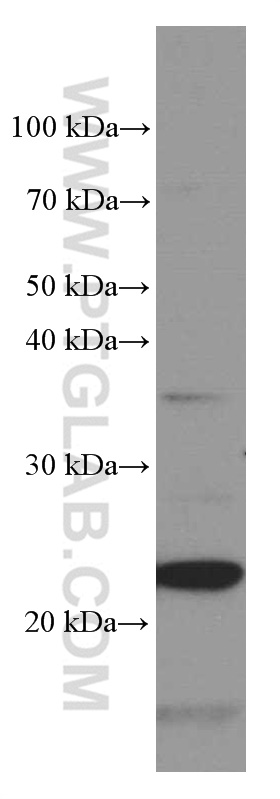验证数据展示
经过测试的应用
| Positive WB detected in | HEK-293 cells, Jurkat cells, K-562 cells, RAW 264.7 cells, fetal human brain tissue |
推荐稀释比
| 应用 | 推荐稀释比 |
|---|---|
| Western Blot (WB) | WB : 1:5000-1:50000 |
| It is recommended that this reagent should be titrated in each testing system to obtain optimal results. | |
| Sample-dependent, Check data in validation data gallery. | |
产品信息
66079-1-Ig targets Phospho-TDP43 (Ser403/404) in WB, IHC, IF, ELISA applications and shows reactivity with human, mouse samples.
| 经测试应用 | WB, ELISA Application Description |
| 文献引用应用 | WB, IHC, IF |
| 经测试反应性 | human, mouse |
| 文献引用反应性 | human, mouse, zebrafish |
| 免疫原 |
Peptide 种属同源性预测 |
| 宿主/亚型 | Mouse / IgG2a |
| 抗体类别 | Monoclonal |
| 产品类型 | Antibody |
| 全称 | TAR DNA binding protein |
| 别名 | ALS10, Phospho-TDP43 (Ser403/404), TAR DNA binding protein, TAR DNA binding protein 43, TARDBP, TDP 43, TDP43, tdp-43 |
| 计算分子量 | 43 kDa |
| 观测分子量 | 25 kDa |
| GenBank蛋白编号 | NM_007375 |
| 基因名称 | TDP-43 |
| Gene ID (NCBI) | 23435 |
| RRID | AB_11183767 |
| 偶联类型 | Unconjugated |
| 形式 | Liquid |
| 纯化方式 | Protein A purification |
| UNIPROT ID | Q13148 |
| 储存缓冲液 | PBS with 0.02% sodium azide and 50% glycerol, pH 7.3. |
| 储存条件 | Store at -20°C. Stable for one year after shipment. Aliquoting is unnecessary for -20oC storage. |
背景介绍
Transactivation response (TAR) DNA-binding protein of 43 kDa (also known as TARDBP or TDP-43) was first isolated as a transcriptional inactivator binding to the TAR DNA element of the HIV-1 virus. Neumann et al. (2006) found that a hyperphosphorylated, ubiquitinated, and cleaved form of TARDBP, known as pathologic TDP-43, is the major component of the tau-negative and ubiquitin-positive inclusions that characterize amyotrophic lateral sclerosis (ALS) and the most common pathological subtype of frontotemporal lobar degeneration (FTLD-U). Various forms of TDP-43 exist, including 18-35 kDa of cleaved C-terminal fragments, 45-50 kDa phospho-protein, 55 kDa glycosylated form, 75 kDa hyperphosphorylated form, and 90-300 kDa cross-linked form. (PMID: 17023659,19823856, 21666678, 22193176).66079-1-Ig is a mouse monoclonal antibody recognizing TDP-43 only when phosphorylated at 403/404. Immunohistochemical analyses using this antibody only stain the insoluble inclusions in pathologic tissues without normal diffuse nuclear staining.
实验方案
| Product Specific Protocols | |
|---|---|
| WB protocol for Phospho-TDP43 (Ser403/404) antibody 66079-1-Ig | Download protocol |
| Standard Protocols | |
|---|---|
| Click here to view our Standard Protocols |
发表文章
| Species | Application | Title |
|---|---|---|
Nat Neurosci TDP-43 condensates and lipid droplets regulate the reactivity of microglia and regeneration after traumatic brain injury | ||
EMBO J Disease-linked TDP-43 hyperphosphorylation suppresses TDP-43 condensation and aggregation. | ||
Eur J Med Chem Targeting nuclear protein TDP-43 by cell division cycle kinase 7 inhibitors: A new therapeutic approach for amyotrophic lateral sclerosis. | ||
Biochemistry Using Tetracysteine-Tagged TDP-43 with a Biarsenical Dye To Monitor Real-Time Trafficking in a Cell Model of Amyotrophic Lateral Sclerosis. | ||
PLoS One Drosophila lines with mutant and wild type human TDP-43 replacing the endogenous gene reveals phosphorylation and ubiquitination in mutant lines in the absence of viability or lifespan defects. |






